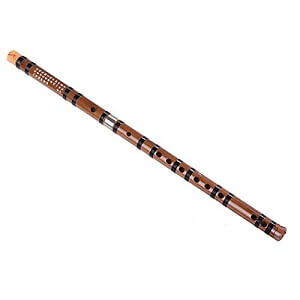Dizi
 The dizi is a side-blown (transverse) edge aerophone (flute) of the Han Chinese. In various forms it is used today in many regional and national forms of Chinese music for solo, small ensemble, and orchestra performance. In the north a relatively short dizi referred to as the bangdi is heard in certain forms of village folk and ritual ensembles. Various versions of this flute have been used in regional opera ensembles for centuries (for example, kunqu, bangzi, and jingju)
The dizi is a side-blown (transverse) edge aerophone (flute) of the Han Chinese. In various forms it is used today in many regional and national forms of Chinese music for solo, small ensemble, and orchestra performance. In the north a relatively short dizi referred to as the bangdi is heard in certain forms of village folk and ritual ensembles. Various versions of this flute have been used in regional opera ensembles for centuries (for example, kunqu, bangzi, and jingju)
Its sound typically associated with civil, as opposed to military, scenes. It is a leading melodic instrument in many regional ‘silk and bamboo’ (‘sizhu’) instrumental ensembles such as those found in the central China area of Jiangnan (see Sizhu Ensemble from China).
As a consequence of the Chinese government’s policy in the second half of the 20th century to emphasize and professionalize traditional Chinese music, dizi performance has been taught in music conservatories and composers have created a significant repertoire of solo works for the instrument. As a result, there are many highly trained concertizing dizi players in China today performing as soloists and in state-sponsored modern chamber and orchestral ensembles. Yet there still are many village and urban contexts in which folk and amateur dizi players are active.
The dizi is made from a straight stalk of bamboo with any internal nodes removed to produce a cylindrical bore. They are made in various lengths (see gallery photo). Just above the blowhole the bore is blocked with a cork stopper, leaving only the far end of the flute open. Six fingerholes, nearly equidistantly placed, are drilled into the lower half of the tube; there is no thumbhole on the reverse side. A distinguishing feature of the dizi is the inclusion of a mirlitone--a membranophonic sound modifier consisting of a hole covered with a tissue paper-thin bamboo membrane that vibrates sympathetically when the flute is sounded. This hole is located between the blowhole and the first fingerhole. Vent holes at the far end determine the acoustical length of the flute, and can be used to tie an ornamental tassel to the instrument. Several rings of silk line are tightly wound around the flute and covered with red lacquer to keep the bamboo from splitting.